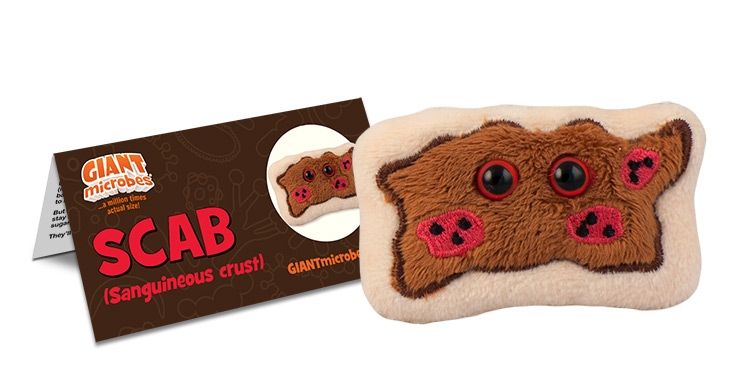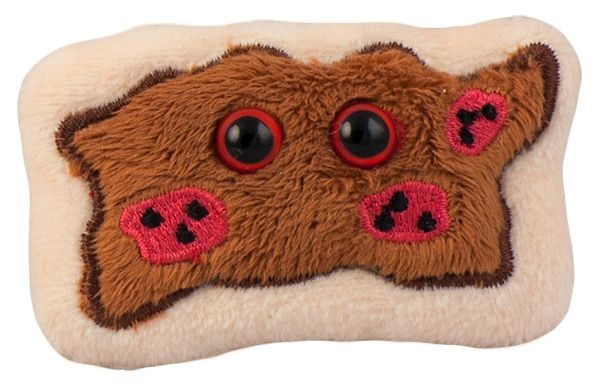Scab (Sanguineous crust)
Most importantly you’ll want to pick this gorgeous scab to add to your GIANTmicrobes collection!
Product Details
Additional Information
| Sizes | Giantmicrobes are based on actual microbes, cells, organisms and other critters, only 1,000,000 times actual size! Gigantic (GG) 16-24" XL (XL) 10-15" Original (PD) 5-8" Keychain (KC) 2-4" with clip |
|---|---|
| Materials | Plush from all new materials. Stuffed with polyester fiber fill. Surface washable: sponge with water & soap, air dry. |
| Packaging | Each plush microbe includes a printed card with fun, educational and fascinating facts about the actual microbe or cell. |
| Safety | Every product meets or exceeds U.S. and European standards for safety. For ages 3 and up. |
All about Scab (Sanguineous crust)
FACTS: Scabs are amazing organic bandages made by your own body. When you have a wound, your body stops the bleeding and forms a clot. Within a few seconds, dried clotted platelets cover over the cut. White blood cells help gobble up any microbes that may have snuck into the cut before the clot was formed. To hold the clot in place, a thread-like protein called fibrin forms a structure throughout the clot. As the fibrin and platelets dry out and the bleeding stops, a shield-like cap forms over the area to protect the wound from infection while new skin grows. This all natural shield is the scab!
Minor wounds heal quickly if you keep them clean. Underneath the scab, the new skin cells grow and gradually form a layer. Once the entire wound is sealed off with new skin, the scab is no longer needed and it falls off. Even if scabs itch and annoy you, it’s not wise to pick them. Premature scab picking could lead to scars and the healing process might have to start all over again. So go ahead and pick someone’s brain, or pick a number, but don’t pick your scabs!
| Description | A scab looks like a hard, reddish blob but is actually the body’s way of forming a natural bandage over broken skin. A scab is formed of special blood cells known as platelets that act as glue to form a clot over scrapes or punctures to prevent blood from flowing out and harmful microbes from flowing in. Other than platelets, thread-like fibrin forms to hold the “bandage” together. |
|---|
| Name | The word derives from the Old English word “sceabb” which was used to describe a scab or itch (any who has ever had one knows that scabs tend to itch.) Old Norse used the word “skabb” for the same skin-related changes. English’s “scab” is a variation of these words. The STI scabies also has a similar root and causes intense itching and scabs to form. |
|---|
| System | Integumentary and immune system |
|---|
| History | A scab begins with specialized, irregularly-shaped blood cells known as platelets. They act fast and rush to a wound and attempt to blow blood flow out of the body. The platelets are assisted by calcium, vitamin K, and fibrin. Fibrin forms a web-like mesh to trap the blood cells because platelets begin to break apart when they sense air. Additionally, white blood cells are deployed to the skin rupture site to attack any bacteria that may have snuck into the body before the clot was formed. All of this occurs ten seconds after a cut forms. |
|---|
| Fascinating Facts |
Blood clots may form under the skin as well, in the form of black-and-blue marks or bruises. Vampire bats have chemicals in their spit that prevent scabs from forming. This makes it easier for them to snack on their victim's blood. So watch out for vampire bats when you have an open wound! Some urban legends say that if you dream about scabs, it means that money is coming your way. |
|---|






